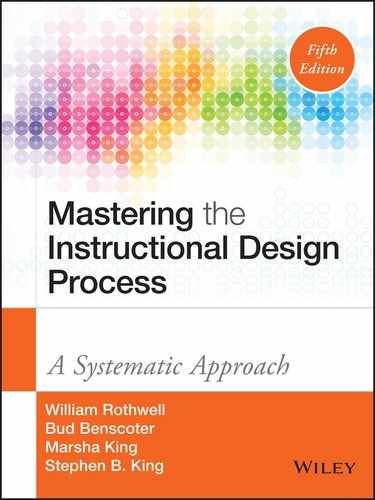Advance Organizer
Use the following instrument as an Advance Organizer for the book. Use it as a diagnostic tool to help you assess the need for improving your instructional design practices. You may also wish to use this instrument to refer directly to parts of the book that may be of special importance to you rightnow.
The Advance Organizer
Directions: Read each item in the left column on the following pages. Spend about 10 minutes on this assessment. In the center column, circle a response that best fits your opinion: 0 = not applicable; 1= strongly disagree; 2 = disagree; 3 = neither agree nor disagree; 4 = agree; and 5 = strongly agree. Be honest! Think of instructional design as you believe you practice it. When you finish, add up the scores and then interpret them as shown at the end of this assessment. Be prepared to share your responses with others, perhaps your mentor(s), as a starting point for improving your instructional design practices. If you would like to learn more about an item, refer to the number in the right column to find the chapter in this book in which the subject is discussed.
| Characteristics of Successful Instructional Design | How Well Do You Meet the Characteristic Based on Your Opinion? (Circle response below) | Chapter in the Book Covering the Topic | |||||
| As an instructional designer, I effectively… | 0 | 1 | 2 | 3 | 4 | 5 | |
| 1. Define instructional design | 0 | 1 | 2 | 3 | 4 | 5 | 1 |
| 2. Conduct a needs assessment | 0 | 1 | 2 | 3 | 4 | 5 | 2 |
| 3. Collect and analyze data for instructional design projects | 0 | 1 | 2 | 3 | 4 | 5 | 3 |
| 4. Identify the target population | 0 | 1 | 2 | 3 | 4 | 5 | 4 |
| 5. Identify environmental characteristics influencing instruction | 0 | 1 | 2 | 3 | 4 | 5 | 4 |
| 6. Use analytical techniques to determine instructional content | 0 | 1 | 2 | 3 | 4 | 5 | 5 |
| 7. Analyze the potential use of existing technologies | 0 | 1 | 2 | 3 | 4 | 5 | 6 |
| 8. Analyze the potential use of emerging technologies | 0 | 1 | 2 | 3 | 4 | 5 | 6 |
| 9. Use an instructional design process appropriate for a project | 0 | 1 | 2 | 3 | 4 | 5 | 7 |
| 10. Organize instructional programs and/or products | 0 | 1 | 2 | 3 | 4 | 5 | 8 |
| 11. Design instructional interventions | 0 | 1 | 2 | 3 | 4 | 5 | 9 |
| 12. Plan noninstructional interventions | 0 | 1 | 2 | 3 | 4 | 5 | 10 |
| 13. Select instructional materials | 0 | 1 | 2 | 3 | 4 | 5 | 11 |
| 14. Modify instructional materials | 0 | 1 | 2 | 3 | 4 | 5 | 11 |
| 15. Develop instructional materials | 0 | 1 | 2 | 3 | 4 | 5 | 12 |
| 16. Design learning assessments | 0 | 1 | 2 | 3 | 4 | 5 | 13 |
| 17. Evaluate instructional interventions | 0 | 1 | 2 | 3 | 4 | 5 | 14 |
| 18. Evaluate noninstructional interventions | 0 | 1 | 2 | 3 | 4 | 5 | 14 |
| 19. Revise instructional and noninstructional interventions | 0 | 1 | 2 | 3 | 4 | 5 | 15 |
| 20. Implement instructional and noninstructional interventions | 0 | 1 | 2 | 3 | 4 | 5 | 16 |
| 21. Apply business skills to manage the instructional design function | 0 | 1 | 2 | 3 | 4 | 5 | 17 |
| 22. Manage partnerships and collaborative arrangements | 0 | 1 | 2 | 3 | 4 | 5 | 18 |
| 23. Plan instructional design projects | 0 | 1 | 2 | 3 | 4 | 5 | 19 |
| 24. Manage instructional design projects | 0 | 1 | 2 | 3 | 4 | 5 | 19 |
| 25. Predict the future of instructional design projects | 0 | 1 | 2 | 3 | 4 | 5 | 20 |
| Total………………………………………………… ____________________ | |||||||
Scoring and Interpreting the Advance Organizer
Total the scores above. Then interpret your score as follows:
| Score | Interpretation |
| 125–101 | Grade your skills at the A level in instructional design. Excellent. Now plan for additional self-improvement. |
| 100–76 | Grade your skills at the B level in instructional design. Now plan for self-improvement in those areas you indicated needed additional improvement. |
| 75–51 | Grade your skills at the C level in instructional design. Average. Now plan for improvement. |
| 50–26 | Grade your skills at the D level in instructional design. Below average. Plan for improvement in those areas you indicated need. Get a mentor, listen to the advice you get, and act on it. |
| 25–0 | Grade your skills at the F level in instructional design. Far below average. Plan for improvement in all areas of instructional design. Get several mentors, listen to the advice they give you, and act on it. Failing that, you might consider a new career. |
